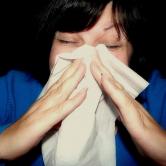Canine Allergies

Dogs, like humans, can also suffer from allergies. Itching of the skin is the most common symptom of a dog allergy. The respiratory tract can be affected causing coughing, sneezing, and/or wheezing. At times, the eyes and nose may develop a discharge. Also, the digestive system may be affected causing vomiting or diarrhea. About 20 percent of the dogs in the United States suffers from some type of allergy, whether it be atopic dermatitis, flea allergy, food allergy, inhalant allergy, contact allergy, or bacterial allergy.
Atopic Dermatitis
An allergic skin disease of dogs, known as canine atopic dermatitis, is caused by the dog's immune system hypersensitivity to common substances in the environment, such as dust mites or molds.
The signs of atopic dermatitis usually appear within the first two years of a dog's life. If the dog begins to groom excessively, with licking or chewing of the paws, abdomen, and hind quarters, then it may suffer from atopic dermatitis. Also, check to see if the ears are reddened and hot to the touch.
A hidden sign that a dog is atopic is in the armpits, groin, or between the toes of the paws. Check to see if there is saliva staining. In light colored dogs, it appears as a red-brown staining. In chronic cases the skin, mostly in the abdomen, may change color from a pinkish, to angry red, to black mottling.
Flea allergy, food allergy, and parasitic infestations may mimic the symptoms of atopic dermatitis making it difficult to diagnose. Once fleas, foods, and parasitic infestations are eliminated as being the offending culprits, then allergy skin testing for dust mites, pollens, and molds may be done to determine what causes the dog's atopic dermatitis.
Flea Allergy The most common form of canine allergy is flea allergy dermatitis. The flea itself is not the culprit in canine flea allergies. It is their saliva that causes the allergic reaction.
A skin allergy test can be preformed to determine if a dog is allergic to flea saliva. If it is, then a strict flea control regimen is required to reduce symptoms. Caution must be used however to make sure the chemicals in the flea preparations are not harmful to the dog.
Just like humans, canine inhalant allergies are caused by pollens (tree, grass, and weed), dust mites, molds, and chemicals.
Although any pure bred or mutt can acquire inhalant allergies, the most common breeds that are affected include terriers (especially the West Highland white terrier, Skye terrier, Scottish terrier and Boston terrier), golden retrievers, poodles, dalmatians, German shepherds, Chinese Shar-peis, shih tzus, lhasa apsos, pugs, Irish setters, and miniature schnauzers.
The symptoms of an inhalant allergy include scratching, biting, chewing at feet and constant licking. The itching may be most severe on feet, flanks, groin, and armpits.
Inhalant allergies are often the reason for recurrent ear infections in your dog.
Food Allergy
Dogs can become allergic to a food they have eaten for years which causes many people to over look the possibility of a food allergy.
Determining the food allergen can be time consuming. First, eliminate all the possible allergens from the diet, by using a home made diet consisting of a protein and a starch the dog has not eaten before. Gradually add back, one at a time for a week, the ingredients of the dog food. If symptoms return, then the offending food allergen should be easily determined. Commercial dog foods can be found that do not contain the offending allergen.
Food sensitivities in a dog may manifest as itchy skin, scratching at ears, shaking of the head, licking and biting at the hind quarters or feet, rubbing faces on carpeting, ear inflammations, coughing, and rarely vomiting, diarrhea, flatulence, sneezing, asthma like symptoms, behavioral changes, seizures, gagging, and vomiting.
Contact Allergy
Contact allergy is the least common of all the types of dog allergies. Some of the common contact allergens include flea collars, wood bedding, grass, plants, and sometimes chemicals and perhaps the shampoo used..
Bacterial Allergy
Several species of Staphylococcus (Staph) bacteria live on normal dog skin. Normally Staph does not cause a problem with its host, but some dogs develop an allergy to it.







